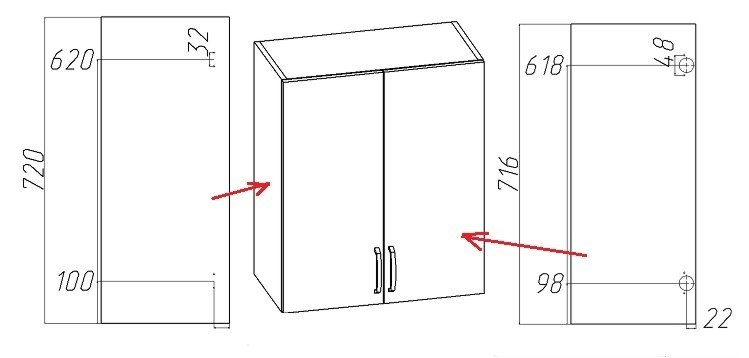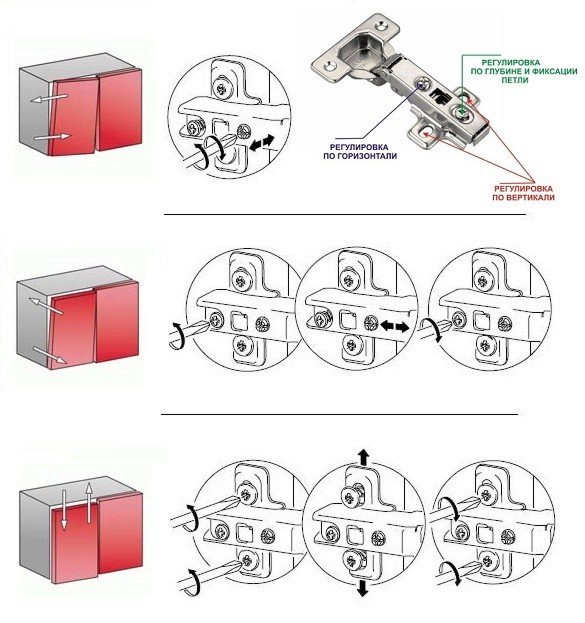Do-it-yourself furniture hinge installation
Hanging facades, installing furniture hinges on them and adjusting them is the final stage of assembling cabinet furniture with your own hands. It depends on how smoothly the hinged doors of the cabinets can be adjusted, whether the furniture will delight with its aesthetic neat appearance. Or annoy with an unevenly exposed front part and a constant creak that accompanies the process of opening and closing.
Rules for installing furniture hinges
As in the article about, we will consider the installation of four-hinged fasteners, with three degrees of adjustment.
The four-hinged hinge consists of two detachable parts:
- The mounting (mounting) bar is attached to the body. At the same time, there is a difference in the markup for internal (inset) and overhead loops.
- The hinge itself is fixed on the facade by installing it in a special technological hole. The depth of the hole is about 12-13 mm, the diameter depends on the size of the bowl. Mostly used accessories with a bowl diameter of 35 mm, less often - 26 mm.
Proper installation of furniture hinges with your own hands involves a preliminary calculation of the required amount, depending on the height and width of the door, its weight.
Hinges with a quantity of three or more per one hinged door are distributed at an equal distance from each other, while you need to follow the markup so that the mounting plate does not “hit” the shelf.
100 mm usually recede from the edge of the facade along the body. Since the door is always 3-4 mm smaller, for the overhead version, the indent to the center of the hole for the bowl is about 98 mm.
Scheme for calculating the number of furniture hinges for installation
There is no unambiguously clear answer to the question of how many hinges are required to be installed on one hinged facade. Each manufacturer of fittings and components gives its own recommendations. Usually, the scheme for calculating the number of furniture hinges is based on two values, the size and weight of the door:
- The height of the door determines the number of connection points with the box. With an insufficient number of hinges, the door may bend over time. Its width is no less important. It is recommended not to design façades that are too wide in relation to their height.
- The weight of the door also plays a role. It is logical to assume that a facade made of laminated chipboard, on top of which a mirror sheet will still be glued, will require additional fasteners. Setting the standard number of furniture hinges may not be able to support the increased weight - reinforcement will be required here.
The standard scheme for installing furniture hinges is as follows.
It can be followed if there are no other recommendations from the manufacturer.
Installation of overhead furniture hinges with markings
Before installation, it will not be superfluous to make a markup so as not to make a mistake when drilling, fastening the mounting plate and bowl. You can use a ready-made template (jig) or measure manually. We take into account the following nuances:
- The overlay facade does not completely close the box. Taking into account the gap, for example, for a kitchen cabinet 720 mm high and 400 mm wide, it will have dimensions of 716x396 mm. And this means that if 100 mm indent from the edge along the box for installing the mounting plate, then the indent along the facade will be less, equal to 98 mm.
- Under the four-hinged hinge on the door, a hole 11 mm deep is selected. This can be done using a Forster drill with a cutting edge and a spout designed specifically for installing furniture hinges (diameter 26 or 35 mm). Special ones have a limiter that will prevent the front part from being pierced through during milling. Provided, of course, that the thickness of the facade is not less than 16 mm.
- The mounting plate fastening depth from the edge of the sidewall of the cabinet when installing the overhead furniture hinge is 37 mm. The distance between the holes at the bar is 32 mm.

Installation of inset (internal) furniture hinges
The only difference when installing an inset furniture hinge is the fastening of the mounting plate on the side of the cabinet. With a standard thickness of a facade made of laminated chipboard (16 mm), 54 mm recede from the edge (the thickness of the facade sheet and 1-2 mm for free play are added to the prescribed 37 mm, for adjustment).

Do-it-yourself furniture hinge adjustment
According to the scheme for installing furniture hinges, a mounting plate is separately attached to two 3x16 mm screws and a bowl (also to two screws), on the side of the box and on the inside of the door, respectively. After the furniture is placed in the allotted place, they begin to hang the facades. To do this, the hinge arm with the bowl is threaded into the mounting plate and tightened onto the fixing screw. It is not worth tightening the fasteners strongly near the bar - all of it is involved in the process of adjusting the furniture hinge with your own hands.
If the floors are littered to the center, then most likely the doors will not be tightly pressed against the box. Adjusting the furniture hinge in depth allows you to pull them tighter or, conversely, loosen the clamp.
For uneven floors, lateral adjustment (horizontal) in combination with vertical adjustment can be useful. With its help, you can align the gaps on double facades, more evenly set them relative to the box.

Also, the adjustment “removes” unpleasant squeaks when opening and closing. It is worth tightening the screws on the hinges from time to time - furniture doors inevitably sag under their own weight. Timely adjustment will extend the life of the mounting hardware.
